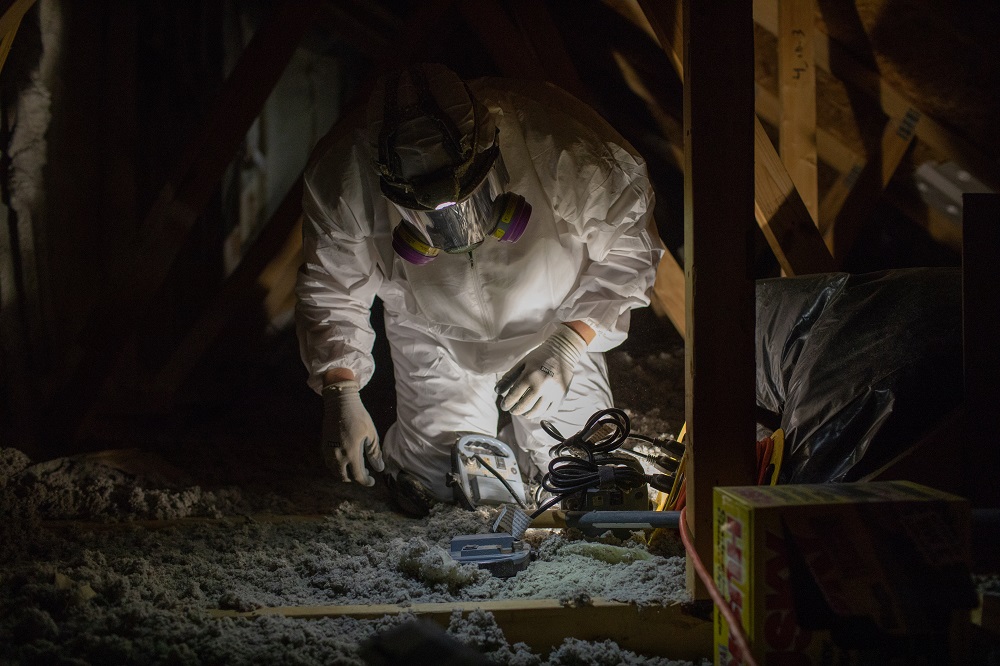Home Insulation Health Hazards

Insulation is a necessity to keep our home at a safe temperature during cold Michigan winters and comfortable during its searing summers. While home insulation is overall beneficial for our home, it does have downsides when it comes to our health. There are pros and cons to different types of insulation, but the health hazards are very similar for each. The drawbacks are primarily related to the installation process for most forms of insulation, which is why trained professionals need to complete this task. Learn about the potential health concerns of each insulation type.
What are the health concerns of spray foam insulation?
Spray foam insulation has gained popularity due to its energy efficiency, air sealing capabilities and fire resistance compared to other forms of insulation. Spray foam insulation that use a blowing agent, hydrofluorocarbons (HFC), during installation release heat-trapping chemicals that are hazardous to the environment and installers. Ecotelligent does not use HFCs during the installation process as it is being banned in many states. Other health concerns of spray foam insulation include:
Respiratory Irritation
During and immediately after the installation of spray foam insulation, volatile organic compounds (VOCs) and other chemicals may be released into the air. These chemicals can cause respiratory irritation, including symptoms such as coughing, wheezing, chest tightness, and shortness of breath.
Skin and Eye Problems
Direct contact with uncured spray foam insulation can cause skin and eye irritation. The chemicals present in the insulation may lead to redness, itching, rashes, or burning sensations on the skin. If the insulation comes into contact with the eyes, it can cause irritation, redness, and potential damage.
Off-Gassing of Chemicals
Spray foam insulation is typically composed of two liquid components that mix together during installation to create the foam. These components may contain isocyanates, which are chemicals known to be respiratory irritants and potential sensitizers. Off-gassing of these chemicals can occur for a period after installation, potentially contributing to indoor air quality concerns.
How to address the health concerns of closed-cell spray foam insulation
All spray foam insulation has an off-gassing period, but most spray foam manufacturers have tested and recommended installers utilize ventilation fans during the installation process to help reduce the length of this period. At Ecotelligent Homes, we use ventilation and recommend clients are not home during the installation and stay somewhere else the night of the installation to ensure they follow the manufacturers' recommendations.
Closed cell spray foam is a premium installation and should be installed by highly trained professionals to ensure the health and safety of the final product. Ecotelligent Homes staff members are Spray Foam Alliance Certified Installers. We follow the latest industry standards and keep the foam on ratio while controlling temperatures to help reduce the risk of bad foam and continuous off-gassing. This ensures the quality of the foam that is sprayed in your home.
What are the health concerns of cellulose insulation?
Cellulose insulation is a type of insulation made from recycled paper and treated with fire retardants. It typically has fewer health concerns compared to some other insulation materials. However, there are a few potential health issues associated with cellulose insulation installation and handling.
Respiratory Tenderness
During the installation process, cellulose insulation can generate dust particles that may be inhaled. Breathing in these airborne particles can cause respiratory irritation, leading to symptoms such as coughing, sneezing, throat irritation, and nasal congestion. Individuals with pre-existing respiratory conditions may be more sensitive to these irritants.
Eye and Skin Annoyance
Direct contact with cellulose insulation fibers can cause skin irritation and redness. If the fibers come into contact with the eyes, they may lead to eye irritation, redness and potential damage. It is advisable to wear protective clothing and goggles when working with cellulose insulation.
How to address the health concerns of cellulose insulation
Blown in cellulose insulation and densely packed cellulose have minimal health risks. The main risks are related to the dust particles that can become airborne during the installation process. To limit the dust, Ecotelligent Homes uses cellulose insulation with binding material added to help reduce the dust generated during the installation. We also utilize drop cloths and plastic coverings inside your home and will typically run an air scrubber with a HEPA filter in the living space to capture the dust.
What are the health concerns of fiberglass insulation?
Fiberglass insulation is widely used in Michigan homes in the attic, walls, floors and ceilings. While it is not as safe as cellulose insulation it is generally considered safe, there are some health concerns associated with fiberglass insulation installation and handling which include:
Skin and Eye Irritation
It is important to wear appropriate protective clothing, including long sleeves, pants, gloves and goggles, when working with fiberglass insulation. Failure to do so can lead to skin and eye irritation. Direct contact with fiberglass insulation can lead to skin irritation, redness, itching and rashes. It can also irritate the eyes if fibers come into contact with them.
Respiratory Issues
Breathing in airborne fiberglass particles can bother the respiratory system, especially individuals with pre-existing respiratory conditions like asthma. Exposure may lead to symptoms such as coughing, wheezing, throat irritation and chest discomfort.
Inhalation of Fine Particles
Fiberglass insulation consists of tiny glass fibers, and if the material is disturbed during installation or removal, it can release fine particles into the air. Inhaling these particles may cause lung irritation or damage, although significant health risks from typical levels of fiberglass exposure are considered minimal.
What are the health concerns of vermiculite insulation?
Vermiculite insulation is no longer used in homes due to asbestos contamination, but it was widely popular between 1940 and 1990. Due to the asbestos, vermiculite insulation can be extremely harmful to your health. If you have vermiculite insulation in your home, these are the health risks associated with it.
Asbestos-Related Diseases
Asbestos is a known carcinogen, and long-term exposure to asbestos fibers can lead to serious health conditions, including asbestos-related diseases such as lung cancer, mesothelioma, and asbestosis. These diseases may develop many years after exposure and can be life-threatening.
Respiratory Concerns
Inhaling asbestos fibers released from vermiculite insulation can cause respiratory problems. The fibers are microscopic and can become lodged in the lungs, leading to inflammation, scarring, and the development of respiratory conditions such as coughing, wheezing, shortness of breath, and chest pain.
Environmental Contamination
Vermiculite insulation containing asbestos can release asbestos fibers into the air. These fibers can spread to other areas of the building, leading to potential exposure for occupants even in areas without direct insulation contact.
To minimize the potential health concerns associated with installing insulation or removing vermiculite insulation, it is advisable to hire trained professionals such as Ecotelligent who follow safety guidelines and best practices. Our team uses proper personal protective equipment, ensures good ventilation during installation when necessary and seals off the work area to prevent the spread of airborne particles. Contact the Ecotelligent Homes team today to learn more about our insulation options for your home.

Ecotelligent Homes
Since 2009, more than 3,000 Michigan homeowners have trusted Ecotelligent Homes to make their homes comfortable and efficient. If you want an energy audit, insulation, HVAC, or abatement services, give us a call anytime: (248) 291-7815. Satisfaction guaranteed.